R.J. Stowell's Blog: rjsomeone, page 34
December 7, 2019
1969
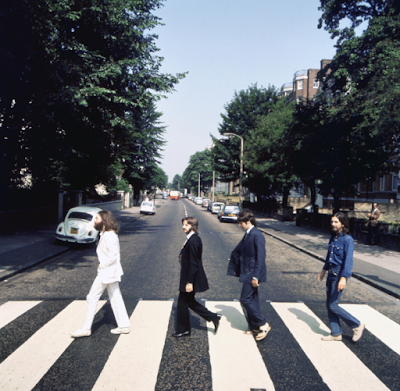 What? You’ve Never Heard These?1969 saw the last recording by The Beatles and the first by Led Zeppelin, Neil Young, Crosby, Stills and Nash and The Allman Bros. 50 years later we still talk about ‘69 as one of the banner years in rock music. On the AM network, we’ve talked enough about Abbey Road and Led Zeppelin and LZ2 (yes, both released in the same year}. Here are some of the greats that don’t get as much attention:Neil Young kicked off the year with his eponymous debut after leaving Buffalo Springfield. It was, indeed, the birth of Americana. Even better was his second offering that year, Everyone Knows This is Nowhere, even better than the first, less than four months later. The LP included “Down By the River” and “Cinnamon Girl.” On my turntable all the time.
What? You’ve Never Heard These?1969 saw the last recording by The Beatles and the first by Led Zeppelin, Neil Young, Crosby, Stills and Nash and The Allman Bros. 50 years later we still talk about ‘69 as one of the banner years in rock music. On the AM network, we’ve talked enough about Abbey Road and Led Zeppelin and LZ2 (yes, both released in the same year}. Here are some of the greats that don’t get as much attention:Neil Young kicked off the year with his eponymous debut after leaving Buffalo Springfield. It was, indeed, the birth of Americana. Even better was his second offering that year, Everyone Knows This is Nowhere, even better than the first, less than four months later. The LP included “Down By the River” and “Cinnamon Girl.” On my turntable all the time.Inspired by the moon landing earlier in the year, The Moody Blues’ To Our Children’s Children’s Children was the 4th of the seven canon Moodies’ LPs that began in 1967 with Days of Future Passed. It was one of the first AOR LPs (Album Oriented Rock) and contained no hit singles; an LP meant to be listened to in its entirety. If the title serves any truth, we’re almost there. The Moodies’ children were born in the late 60s, their grandchildren in the 80s, and the “Children’s Children’s Children have already been born.Greatly overlooked is Quicksilver Messenger Service’s Happy Trails. Quicksilver was one of the essential San Francisco psychedelic bands, but had a uniquely country folk flavor. Side one is one of live music’s classics, a side filling rendition of Bo Diddley's “Who Do You Love” with its samplings of genres including jazz, country, folk, and blues. It too is one of the great AOR LPs and contained no popular singles.One of my all-time favorite singles is Isaac Hayes’ theme from Shaft. It’s kitschy and fun and a great singalong, but Hayes’ masterpiece is so cruelly overlooked, Hot Buttered Soul. Its production values, instrumentation and soul make for one of the romantic LPs of 60s.Let’s round it out with the Latin Beats and incredible musicianship of Santana’s self-titled debut. After one of Woodstock’s iconic performance, Columbia pressed hard for the success of the LP and found it based on the single, “Evil Ways.” After 50 years as a band, the debut may still be its greatest achievement.It was the year of Tommy, The Stooges, King Crimson, Bowie’s “Space Oddity,” Let It Bleed and Zappa’s Hot Rats, and that’s just a taste. Wow.
When all was said and done, here was the top ten for the decade:1 The Beatles – Sgt. Pepper's Lonely Hearts Club Band - 1967
2 The Beatles - Abbey Road - 1969
3 The Beatles - Revolver - 1966
4 The Beatles - The Beatles (The White Album) - 1968
5 Led Zeppelin - Led Zeppelin 2 - 1969
6 The Beatles - Rubber Soul - 1965
7 The Beatles - A Hard Day's Night - 1964
8 Leonard Bernstein - West Side Story - 1962
9 The Doors - The Doors - 1967
10 The Rolling Stones - Let It Bleed – 1969
Published on December 07, 2019 07:22
December 5, 2019
Miles in California - Free on Kindle Unlimited
For the past several months we’ve offered Miles from Nowhere on Kindle Unlimited for FREE.
But here’s an even better deal!
Get Kindle Unlimited for JUST 99¢ for THREE MONTHS. Click here.
That’s right, now you can read RJStowell’s Miles From Nowhere AND Jay and the Americans on Kindle along with a million other titles, from Harry Potter to The Lord of the Rings – audiobooks, too! FREE.
AM is supported by sales from Miles and from Jay and the Americans. Unlike Patreon, when you offer up your hard-earned cash, you get something in return. Want a hand-signed edition of either novel, send me an email. Enjoy.
Published on December 05, 2019 16:26
December 2, 2019
The Double A-Side
 On Dec. 7, 1948, RCA Victor Records released the first 45, "Pee-Wee the Piccolo" by Paul Wing with Russ Case and His Orchestra, aimed at the children's market. The company bet that its new 7-inch records would replace the standard 10-inch 78s that had dominated the music industry since the 1920s. RCA's entry into the adult market would come on March 31, 1948. Columbia Records had introduced the 33 1/3, a.k.a. the album or LP, in 1948. The 45 was RCA's answer. The speeds 78 and 33 are basically random, by the way, but you'll notice that 78-33=45.
On Dec. 7, 1948, RCA Victor Records released the first 45, "Pee-Wee the Piccolo" by Paul Wing with Russ Case and His Orchestra, aimed at the children's market. The company bet that its new 7-inch records would replace the standard 10-inch 78s that had dominated the music industry since the 1920s. RCA's entry into the adult market would come on March 31, 1948. Columbia Records had introduced the 33 1/3, a.k.a. the album or LP, in 1948. The 45 was RCA's answer. The speeds 78 and 33 are basically random, by the way, but you'll notice that 78-33=45. RCA Victor released several new recordings simultaneously on that day, including "Texarkana Baby," a huge hit for country's Eddy Arnold. By May of that year, with 45 phonographs flying off the shelves, RCA's single of Perry Como’s "'A' You're Adorable" reached the top spot, the very first No. 1 on the Billboard charts for the new format.
The 45 was perfect for the new rock 'n' roll sound and tapped into a new demographic of buyers, the American teen. Due to the 45's compact size, teenagers could grab a handful of records and take them to a friend's, where they could dance the night away to their favorite tunes by Elvis, Jerry Lee, Chuck and the rest.
In the early days and even beyond, only the A-sides mattered. And it has only been with the resurgence of vinyl that collectors and music aficionados are discovering the B-side as a new collection of forgotten songs often not included on an LP. Let's call it "rediscovery," since the frugal teen buyer wanted a bang for his or her buck.
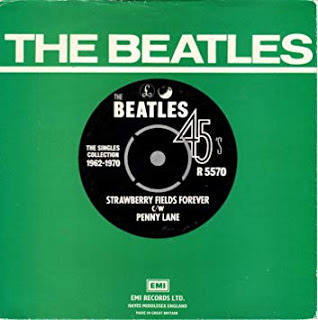 Ah, but then there are thedouble A-sides. The Beatles, of course, had four British Double-A's (more in the U.S.): "Day Tripper/We Can Work it Out," "Eleanor Rigby/Yellow Submarine," "Penny Lane/Strawberry Fields" and "Come Together/Something." But there were plenty more; more than a hundred, in fact. Here are some of the best (not all are truly double A-sided, but two songs of equal stature):
Ah, but then there are thedouble A-sides. The Beatles, of course, had four British Double-A's (more in the U.S.): "Day Tripper/We Can Work it Out," "Eleanor Rigby/Yellow Submarine," "Penny Lane/Strawberry Fields" and "Come Together/Something." But there were plenty more; more than a hundred, in fact. Here are some of the best (not all are truly double A-sided, but two songs of equal stature): Led Zeppelin — "Whole Lotta Love/Living Loving Maid (She’s Just a Woman)" (1969).
The LP was Led Zeppelin's domain and their music was meant to be heard that way in the new era of AOR. In fact, they didn’t even release any singles in the U.K. In the U.S. an edited version of "Whole Lotta Love" made the U.S. top 10.
Crosby, Stills & Nash — "Suite: Judy Blue Eyes/Long Time Gone" (1969).
CSN released these two tracks from their self-titled Atlantic album. Stephen Stills' acoustic ode to girlfriend Judy Collins made for a marked contrast to David Crosby's rocker.
The Band — "Up on Cripple Creek/The Night They Drove Old Dixie Down" (1969).
From The Band's landmark sophomore album, this was the beginning of what today we often call Americana.
The Monkees — "I'm a Believer/(I'm Not Your) Steppin’ Stone" (1966).
The B-Side here only made it to No. 20 (with "I'm a Believer" a No. 1 smash), but what a B-side it is. Paul Revere and the Raiders had cut the Boyce Hart song previously on an LP, but it was the Monkees that had the hit. This is the list's only entry not from 1969.
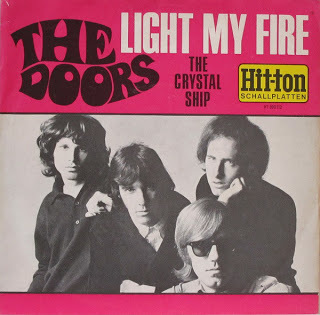 Another that didn't even make the list...The Guess Who — "Laughing/Undun" (1969).
Another that didn't even make the list...The Guess Who — "Laughing/Undun" (1969).Nowhere near the top spot, but each of these rate right up there in my book. "Laughing" went to No. 10 and "Undun" to No. 22 in the States. Creedence Clearwater Revival — "Proud Mary/Born on the Bayou" (1969).
Did you realize that CCR never had a No. 1 single? That’s right: On five occasions they reached No. 2. Like The Beatles, Creedence embraced the Double A-Side with "Bad Moon Rising/Lodi," "Down on the Corner/Fortunate Son," and "Travelin' Band/Who'll Stop the Rain."
The Rolling Stones — "Honky Tonk Women/You Can't Always Get What You Want" (1969).
You want two sides of perfection? You can get that all over The Stones' discography: "Ruby Tuesday/Let’s Spend the Night Together," or "Street Fighting Man/No Expectations" but it just does not get any more classic than the gritty "Honky Tonk Women" pairing up with "You Can’t Always Get What You Want."
Published on December 02, 2019 05:49
December 1, 2019
Miles for the Holidays
"It's 50 years since Woodstock. If you were there, they say you won't remember. I remember..."
Miles From Nowhere is a hippie pilgrimage, the journey of a young man in poor health hoping to join the half-million strong. Recovering from kidney failure, Miles is hell-bent on Woodstock. After his father, Miles' transplant donor, succumbs to complications, Miles takes that long trek across the country, from California to New York, but the country gets in the way. In it, he finds love and lust, forgiveness, acceptance, communists, saints and sinners. Spoiler, Miles makes it to Woodstock, but only in time for Hendrix. Like all of us, you know, it's all about the journey.
But what would the journey be without music? The rock 'n' roll of 50 years ago, from Hendrix to the Who to Otis Redding, is like a character in the novel, a soundtrack in words. Travel across the country with Miles and his hippie entourage, all the while singing about the rain and love and peace.
Get your copy of Miles From Nowhere, available on Amazon. Click here to order.
For a personalized copy, contact AM at rjsomeone@gmail.com.
Published on December 01, 2019 14:07
November 28, 2019
Happy Thanksgiving!
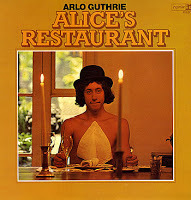 Recorded in 1967, Arlo Guthrie's "Alice's Restaurant," the 18- minute counterculture anthem recounts the storyteller's real-life encounter with the law on Thanksgiving Day 1965. As the song unfolds, we hear all about how a hippie-bating police officer by the name of William "Obie" Obanhein arrested Arlo for littering. (Cultural footnote: Obie previously posed for several Norman Rockwell paintings, including the well-known painting, "The Runaway," that graced a 1958 cover of The Saturday Evening Post.) In fairly short order, Arlo pleads guilty to a misdemeanor charge, pays a $25 fine, and cleans up the trash.
Recorded in 1967, Arlo Guthrie's "Alice's Restaurant," the 18- minute counterculture anthem recounts the storyteller's real-life encounter with the law on Thanksgiving Day 1965. As the song unfolds, we hear all about how a hippie-bating police officer by the name of William "Obie" Obanhein arrested Arlo for littering. (Cultural footnote: Obie previously posed for several Norman Rockwell paintings, including the well-known painting, "The Runaway," that graced a 1958 cover of The Saturday Evening Post.) In fairly short order, Arlo pleads guilty to a misdemeanor charge, pays a $25 fine, and cleans up the trash. 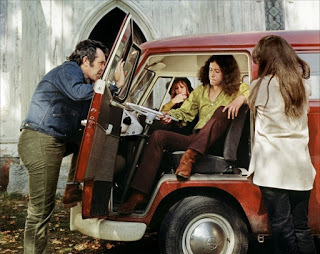 But the story isn't over. Not by a long shot. Later, when Arlo (son of American icon Woody Guthrie) gets called up for the draft, the petty crime ironically becomes a basis for disqualifying him from military service in the Vietnam War.
But the story isn't over. Not by a long shot. Later, when Arlo (son of American icon Woody Guthrie) gets called up for the draft, the petty crime ironically becomes a basis for disqualifying him from military service in the Vietnam War. Guthrie recounts this with some bitterness as the song builds into a satirical protest against the war: "I’m sittin' here on the Group W bench 'cause you want to know if I'm moral enough to join the Army, burn women, kids, houses and villages after bein' a litterbug." And then we're back to the cheery chorus again: "You can get anything you want, at Alice's Restaurant." Who would have thought that a Thanksgiving tradition was born. The song would later become the inspiration for the 1969 cult classic film of the same name.
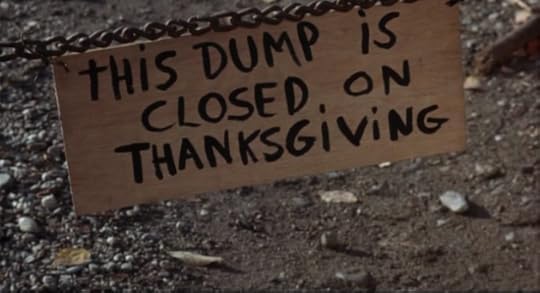
Published on November 28, 2019 08:54
November 25, 2019
Baroque Pop
Baroque Pop emerged in the mid-1960s when Pop and Rock recording artists began incorporating elements of Western Classical Music into their production; the ultimate contribution, of course, the Beatles' Sgt. Pepper. Many pop songs by then had already made use of instruments previously associated with classical music, such as harpsichord and strings, but Baroque Pop was distinguished for a majestic, melancholic sound that was more reminiscent of the Baroque Music of the 17th and 18th centuries. Bands like Gentle Giant and Jethro Tull would take the madrigal sound to its extreme in the 1970s. With Bach heavily integrated into the mix, Baroque Pop often utilized counterpoint, two separate melodies that intersect. Baroque Pop adds on non-classical instruments like guitars, electric organ, and drums plus eastern influences like the sitar, but its orchestral qualities are always placed in the arrangement's forefront.
Popular examples are The Left Banke's "Walk Away Renée," The Beach Boys' "God Only Knows" and The Beatles' "Eleanor Rigby" which feature a string quartet. Others, like The Zombies' "Time of the Season" and Procol Harum's "A Whiter Shade of Pale" don’t contain classical instrumentation, but are still of the style due to their baroque-like features, particularly on the Bach-inspired organ melodies that play throughout "A Whiter Shade of Pale." It's definitely Pop and not Rock, maybe rock lite, with a harpsichord, a pot of tea and two cats in the yard.
In the UK, baroque's starting point was the Zombies' "She's Not There," which stuck out dramatically in 1964. The Zombies went on to record "Summertime," which sounded more like "Greensleeves" than Gershwin.
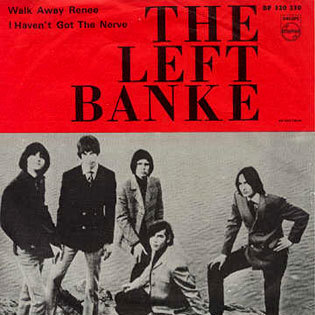 In New York, Michael Brown must have bought the 45 of "She's Not There," which was a far bigger hit in the States. Brown formed a band called the Left Banke and roped in his dad, an arranger called Harry Lookofsky, to oversee their first single. "Walk Away Renee" was the first bona fide baroque pop hit at the end of 1965.
In New York, Michael Brown must have bought the 45 of "She's Not There," which was a far bigger hit in the States. Brown formed a band called the Left Banke and roped in his dad, an arranger called Harry Lookofsky, to oversee their first single. "Walk Away Renee" was the first bona fide baroque pop hit at the end of 1965. In the mid-60s, harpsichords and string quartets were all over the place, even the Rolling Stones had "Lady Jane." Sgt. Pepper was the high point, but the influence of Baroque Pop was far-reaching with bands like Strawberry Alarm Clock and up and coming singer/songwriters like Nick Drake and Jeff Buckley, and early, pre-Buckingham Nicks, Fleetwood Mac. Maybe the ultimate nod, in addition to Tull and Gentle Giant was Renaissance, with the lilting vocals of Annie Haslam.
Other 60s contributions include the BeeGees, Harper’s Bizarre with Paul Simon’s “59th Street Bridge Song,” which everyone thinks is called "Feelin' Groovy," and one-hit wonders like Mercy's "Love" and the Peppermint Rainbow's "Will You Be Staying After Sunday."
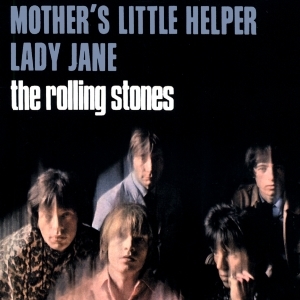 We've talked in the past about how the Wrecking Crew, that mix of L.A. musicians who figured so prominently in the pop music of the mid-60s, from The Mamas and the Papas to Sonny and Cher and a hundred or so top singles, but Baroque Pop, taking its cue from The Moody Blues' Days of Future Passed, instead used full orchestration. From London to L.A., classical musicians were now pop stars.
We've talked in the past about how the Wrecking Crew, that mix of L.A. musicians who figured so prominently in the pop music of the mid-60s, from The Mamas and the Papas to Sonny and Cher and a hundred or so top singles, but Baroque Pop, taking its cue from The Moody Blues' Days of Future Passed, instead used full orchestration. From London to L.A., classical musicians were now pop stars.Recorded in November 1969 was Edison Lighthouse's "Love Grows," a song you know but probably never even heard the name Edison Lighthouse. It was a top ten smash and stands alongside "Walk Away Renee" and "Elenore Rigby" as a pinnacle example of the genre.But don't think the genre didn’t last. You can't listen to Tears for Fears or Arcade Fire, The Decemberists, Death Cab For Cutie or any of the new folk artists like Fleet Foxes or Sun Kil Moon without understanding their tribute to baroque pop.
Recorded this week in 1969, "Love Grows” by Edison Lighthouse.
Published on November 25, 2019 05:58
November 22, 2019
Led Zeppelin - The Carousel - An Excerpt from Miles From Nowhere
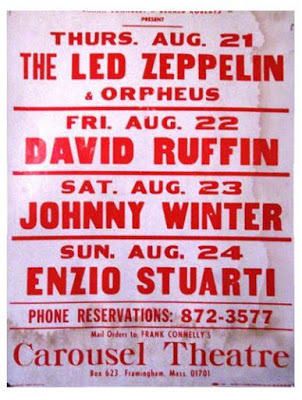 To my delight and despite my funk, the Carousel was a circus tent in the middle of a grassy field. Had there been elephants, I wouldn’t have been surprised. There were no cars in the lot, only a van backed up to the tent. Inside was a low stage and a wall of amps.
To my delight and despite my funk, the Carousel was a circus tent in the middle of a grassy field. Had there been elephants, I wouldn’t have been surprised. There were no cars in the lot, only a van backed up to the tent. Inside was a low stage and a wall of amps.I was tired and uncomfortable. I fell asleep in the back of the van. When I awoke it was dark and the big top was lighted from within, an atmospheric glow that made it seem sleepy and unreal. I got out of the van and a guy was leaning against my door. He apologized. His friends were sitting on the hood of a powder blue Corvair, passing around a joint. I figured I’d share; it’s what you do.
They were nice people. Big Zeppelin fans. One had a guitar. He was trying to play some blues thing and getting frustrated. Then he played “Embryonic Journey,” an instrumental from the Jefferson Airplane. I liked watching his fingers. He played it expertly. I said, “That was great, man.”
I figured I’d get something to eat. They had a snack bar like a drive-in theater, with hamburgers and hot dogs wrapped in tin foil bags. I walked over with the guy who’d been leaning on my car and his girl, a pretty thing who didn’t say a word. If she was mute it would have made sense. But she had a pretty smile.
Turned out I didn’t really want anything. I didn’t feel well. I got a chocolate milk and some fries, and I lost them in line. The lady at the cash register said, “You okay?” I shrugged and gave her a quarter.
Across the way was the ticket booth, just like at an amusement park. Tickets were $4.00, and I went inside. It was crowded, but when you’re alone you can excuse your way through, and I laced my way in and out to stake my claim in the front by a bank of amps. The stage was low enough to sit on and I sat looking out at the masses. It was a different crowd than Woodstock. Woodstock was a hippie paint-by-numbers; this seemed like something from our future, what we could expect from the 70s; the difference like chalk and cheese. There weren’t any dandies or flower girls. The guys wore flared pants and tight t-shirts, their hair bushy and wild, and the girls, wild prints and blouses that accentuated their figures, braless and formfitting. The atmosphere made Woodstock seem like the end of something, and this, here in a circus tent, was the beginning of something else.
I didn’t know anything about the Zeppelin. Don the Hippie used to play the LP. It was loud and voracious, brash and beautiful as well. I didn’t know the names of the songs or the names of the band members, only that it was super bluesy and passionate.

The band came out on the stage. They weren’t but a few feet away. I recognized the guitarist from The Yardbirds. He had a very distinctive look. He wore crushed velvet pants and a peach-colored faded Henley, and the singer had flared jeans and a gauzy shirt like Lori wore in hippie-mode. He had shaggy hair below his shoulders. He was handsome, almost pretty.
The announcer said, “Ladies and Gentlemen, please welcome the Led Zeppelin,” and immediately they started to jam; a crazy, off-kilter blues song with a frantic harmonica. I guess I’m a little naïve, I guess I over-simplify things, but in my mind it really was about a train. The imagery in my head was a railroad semaphore, its lights flashing, the steam whistle of a locomotive in the distance.
My two new friends were over on the other side of the stage really rockin’ out and singing the refrain, “Train kept a-rollin’, all night long.” He was standing behind her with his hands on her waist and he was grinding against her. I got it, suddenly, how wrong I was.And when it wasn’t just raw passion, the singer moaned about lost love, unabashedly sorry for himself, and lonesome. These songs were like nothing ever heard before. It was sheer power, each member of the band unparalleled in what they did; and not only because no one else was doing it. The music was a ritual, with the band, like magicians or shamans, giving off energy, the audience taking the energy in, then offering it back. It really did seem like Woodstock was yesterday, and here in front of me was tomorrow. They played a lovely if convoluted instrumental called “Black Mountain Side,” and the audience, a thousand hero worshippers, were transfixed, silent and in awe. I was standing by a huge rack of amps and each note would reverberate inside me, negating how awful I felt. Suddenly, I was weak and out of it. I sat on the edge of the stage and took a breath. I closed my eyes and opened them again. I saw Jimmy Page there before me, his black and white Danelectro morphing in and out of focus.
It was the last thing I remember.
Published on November 22, 2019 06:00
Led Zeppelin II - 50 Years Ago
During September 1968, The New Yardbirds (Jimmy Page, John Bonham, John Paul Jones and Robert Plant) toured Scandinavia performing Yardbirds material as well as new material like "Communication Breakdown," "I Can't Quit You, Baby," "Babe I'm Gonna Leave You," and "How Many More Times." That same month, at Keith Moon's mocking ("That'll go down like a lead zeppelin), The New Yardbirds were renamed Led Zeppelin, and on October 15, 1968, Led Zeppelin made their debut at Surrey University. Soon after, the group began touring the U.S., backing up headliners like Vanilla Fudge and The MC5. Nearly instantaneous recognition followed. On January 31, 1969, Led Zeppelin opened for Iron Butterfly, who, due to "In a Gadda Da Vida," was one of the hottest bands in the world. Led Zeppelin received such resounding approval from the audience that Doug Ingle, lead singer for the Butterfly scrapped the remainder of the tour. Led Zeppelin had become headliners in their own right.
Led Zeppelin would end up opening for Vanilla Fudge with the band name mistakenly advertised as "Len Zeffelin." Doesn't quite have the same ring to it. No one had ever heard anything like it. By the time Zeppelin left the stage, psychedelia was dead and heavy metal was born. Poor Vanilla Fudge.
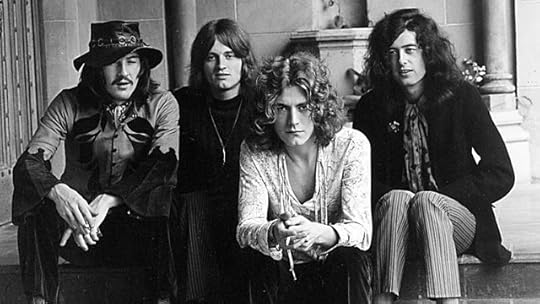
Within eight months of their official debut, Zeppelin was at the top of the bill at the Playhouse Theater in London, and the Pop Proms at the Royal Albert Hall. On October 17, 1969, a year after the band's inception, Zeppelin played Carnegie Hall, ending a ban on rock groups caused by the Rolling Stones' antics in 1965.
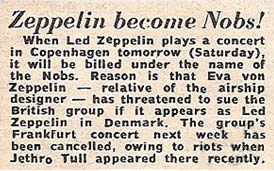 While playing in Denmark, Eva von Zeppelin, a relative of the designer of the airship, Ferdinand von Zeppelin, threatened to sue the band if they used the name for their gig in Copenhagen. For that one show, Led Zeppelin played under the alias, The Nobs.
While playing in Denmark, Eva von Zeppelin, a relative of the designer of the airship, Ferdinand von Zeppelin, threatened to sue the band if they used the name for their gig in Copenhagen. For that one show, Led Zeppelin played under the alias, The Nobs.
The first LP took but 36 hours of studio time, including mixing and mastering and was fit into the band's hectic touring schedule. The band was without a label and on the clock to the tune of £1,782, or roughly $3,500. Released January 12, 1969, in the U.S., Led Zeppelin climbed to No. 10 in the U.S. and to No. 6 in the U.K. (Released March 28th). Until the late 60s, producers placed microphones directly in front of the amplifiers and drums. For Led Zeppelin, Page placed an additional microphone some distance from the amplifier (as far as twenty feet) and then recorded the balance between the two. By adopting this "distance equals depth" technique, Page was among the first producers to record a band's "ambient sound;" the distance of a note's time-lag from one end of the room to the other. Led Zeppelin was the first album to be released in stereo-only form; at the time, the practice of releasing both mono and stereo versions was the norm. The LP was the virtual Sgt. Pepper of Heavy Metal Blues.
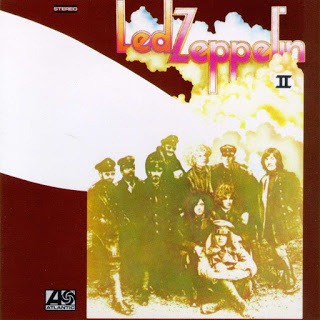 Somehow, this band of misfits broke down the walls of critics (who abhorred the first LP) going straight for the audience, and won with their interpolation of blues, garage rock, soul, shuffle, psychedelic vibes and violin-bowed guitar fer chrissakes; they were over-the-top and minimalist, often in the same song. With tracks about hobbits, mythology and sex in equal form, Led Zeppelin made it look easy.
Somehow, this band of misfits broke down the walls of critics (who abhorred the first LP) going straight for the audience, and won with their interpolation of blues, garage rock, soul, shuffle, psychedelic vibes and violin-bowed guitar fer chrissakes; they were over-the-top and minimalist, often in the same song. With tracks about hobbits, mythology and sex in equal form, Led Zeppelin made it look easy.
Led Zeppelin's debut album (AM8) is a monster of barely contained monolithic intensity (yeah pompous as shit). The album's artistic success hinges on the tension between the reflective/creative/experimental natures of Jimmy Page and John Paul Jones rubbing elbows with the bombastic/flamboyant/amped-up traditionalism of Robert Plant and John Bonham. When these tensions interact fireworks ensue. These are basic musical forms, blues, folk and bluegrass, taken to new extremes of sonic density and timbrel heaviness. Here was a conscious move to unearth the swamp blues from which all rock and roll originated and, at the same time, revitalize the format for a contemporary audience. The likes of The Yardbirds, The Small Faces, John Mayall's Bluesbreakers and Joe Cocker fronted a movement that occasionally bruised the singles chart, but was primarily an underground faction. Hendrix, Beck and Cream pushed this to another, darker dimension and Zeppelin's debut was an integral player in the cadre that opened the floodgates to a bevy of progressive bands whose growing obsession with self-indulgent, sprawling epics lead to an inevitable implosion and the backlash that was punk. That's a lot of rock history in one breath: Led Zeppelin was the catalyst for it all. By year's end, the band released Led Zeppelin II (Led Zeppelin II, quickly moved up to No. 1 in both the U.S. and the U.K., remaining on the charts for 98 weeks in the States and an astounding 138 weeks in Britain.)
 As we've reported, Led Zeppelin chose to skip Woodstock for their first American tour, playing the Asbury Park Convention Center instead with a crowd of 1500. Just after Woodstock, the band played The Carousel in Framingham, Massachusetts. You can read an account of what that was like in my novel Miles From Nowhere.
As we've reported, Led Zeppelin chose to skip Woodstock for their first American tour, playing the Asbury Park Convention Center instead with a crowd of 1500. Just after Woodstock, the band played The Carousel in Framingham, Massachusetts. You can read an account of what that was like in my novel Miles From Nowhere.
Late in '69 we'd just moved to a new apartment in North Hollywood. There was no furniture in the living room, bar the white Mediterranean style console stereo. My mother was putting up new curtains and my brother put on Zeppelin II. The acoustic effects (because of the empty room) were amazing, and the transfer of sound from one speaker to the other intensified my fascination. My mother yelled, "Turn that down." There may have been the insertion of an expletive. Nothing seals one's affinity for a rock LP like the criticism of a parent. Just eight years old at the time, I was sold.
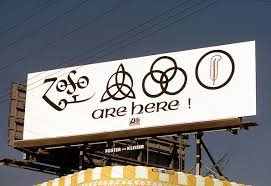 Want to know what hard rock is? Led Zeppelin II (AM8), no bones about it. Zep II delivers in spades with bountiful and bludgeoning force, sex-hot passion, and intricate grace. "Whole Lotta Love" immediately seduces with Page's strutting chops, driving drums and Plant's mile-high wails before hurtling the listener into a sparse and shaky atmosphere of twitching percussion and mind-bending guitar squeals. And that's just the first track. Just try to sit still through "The Lemon Song," absorb the beautifully understated "Thank You" and don't forget the Bonham showcase "Moby Dick." This album exhibits a handful of the most influential songs in rock history with blues-soaked attitude to spare, indulgences in instrumentation that have yet to be surpassed, and compositions designed to rock your ass. Zep II is why the boys had their own private jet.
Want to know what hard rock is? Led Zeppelin II (AM8), no bones about it. Zep II delivers in spades with bountiful and bludgeoning force, sex-hot passion, and intricate grace. "Whole Lotta Love" immediately seduces with Page's strutting chops, driving drums and Plant's mile-high wails before hurtling the listener into a sparse and shaky atmosphere of twitching percussion and mind-bending guitar squeals. And that's just the first track. Just try to sit still through "The Lemon Song," absorb the beautifully understated "Thank You" and don't forget the Bonham showcase "Moby Dick." This album exhibits a handful of the most influential songs in rock history with blues-soaked attitude to spare, indulgences in instrumentation that have yet to be surpassed, and compositions designed to rock your ass. Zep II is why the boys had their own private jet.
Don't forget your copy of Miles available on Amazon. Click the link in the sidebar for the softbound and Kindle editions.
Led Zeppelin would end up opening for Vanilla Fudge with the band name mistakenly advertised as "Len Zeffelin." Doesn't quite have the same ring to it. No one had ever heard anything like it. By the time Zeppelin left the stage, psychedelia was dead and heavy metal was born. Poor Vanilla Fudge.

Within eight months of their official debut, Zeppelin was at the top of the bill at the Playhouse Theater in London, and the Pop Proms at the Royal Albert Hall. On October 17, 1969, a year after the band's inception, Zeppelin played Carnegie Hall, ending a ban on rock groups caused by the Rolling Stones' antics in 1965.
 While playing in Denmark, Eva von Zeppelin, a relative of the designer of the airship, Ferdinand von Zeppelin, threatened to sue the band if they used the name for their gig in Copenhagen. For that one show, Led Zeppelin played under the alias, The Nobs.
While playing in Denmark, Eva von Zeppelin, a relative of the designer of the airship, Ferdinand von Zeppelin, threatened to sue the band if they used the name for their gig in Copenhagen. For that one show, Led Zeppelin played under the alias, The Nobs.The first LP took but 36 hours of studio time, including mixing and mastering and was fit into the band's hectic touring schedule. The band was without a label and on the clock to the tune of £1,782, or roughly $3,500. Released January 12, 1969, in the U.S., Led Zeppelin climbed to No. 10 in the U.S. and to No. 6 in the U.K. (Released March 28th). Until the late 60s, producers placed microphones directly in front of the amplifiers and drums. For Led Zeppelin, Page placed an additional microphone some distance from the amplifier (as far as twenty feet) and then recorded the balance between the two. By adopting this "distance equals depth" technique, Page was among the first producers to record a band's "ambient sound;" the distance of a note's time-lag from one end of the room to the other. Led Zeppelin was the first album to be released in stereo-only form; at the time, the practice of releasing both mono and stereo versions was the norm. The LP was the virtual Sgt. Pepper of Heavy Metal Blues.
 Somehow, this band of misfits broke down the walls of critics (who abhorred the first LP) going straight for the audience, and won with their interpolation of blues, garage rock, soul, shuffle, psychedelic vibes and violin-bowed guitar fer chrissakes; they were over-the-top and minimalist, often in the same song. With tracks about hobbits, mythology and sex in equal form, Led Zeppelin made it look easy.
Somehow, this band of misfits broke down the walls of critics (who abhorred the first LP) going straight for the audience, and won with their interpolation of blues, garage rock, soul, shuffle, psychedelic vibes and violin-bowed guitar fer chrissakes; they were over-the-top and minimalist, often in the same song. With tracks about hobbits, mythology and sex in equal form, Led Zeppelin made it look easy.Led Zeppelin's debut album (AM8) is a monster of barely contained monolithic intensity (yeah pompous as shit). The album's artistic success hinges on the tension between the reflective/creative/experimental natures of Jimmy Page and John Paul Jones rubbing elbows with the bombastic/flamboyant/amped-up traditionalism of Robert Plant and John Bonham. When these tensions interact fireworks ensue. These are basic musical forms, blues, folk and bluegrass, taken to new extremes of sonic density and timbrel heaviness. Here was a conscious move to unearth the swamp blues from which all rock and roll originated and, at the same time, revitalize the format for a contemporary audience. The likes of The Yardbirds, The Small Faces, John Mayall's Bluesbreakers and Joe Cocker fronted a movement that occasionally bruised the singles chart, but was primarily an underground faction. Hendrix, Beck and Cream pushed this to another, darker dimension and Zeppelin's debut was an integral player in the cadre that opened the floodgates to a bevy of progressive bands whose growing obsession with self-indulgent, sprawling epics lead to an inevitable implosion and the backlash that was punk. That's a lot of rock history in one breath: Led Zeppelin was the catalyst for it all. By year's end, the band released Led Zeppelin II (Led Zeppelin II, quickly moved up to No. 1 in both the U.S. and the U.K., remaining on the charts for 98 weeks in the States and an astounding 138 weeks in Britain.)
 As we've reported, Led Zeppelin chose to skip Woodstock for their first American tour, playing the Asbury Park Convention Center instead with a crowd of 1500. Just after Woodstock, the band played The Carousel in Framingham, Massachusetts. You can read an account of what that was like in my novel Miles From Nowhere.
As we've reported, Led Zeppelin chose to skip Woodstock for their first American tour, playing the Asbury Park Convention Center instead with a crowd of 1500. Just after Woodstock, the band played The Carousel in Framingham, Massachusetts. You can read an account of what that was like in my novel Miles From Nowhere. Late in '69 we'd just moved to a new apartment in North Hollywood. There was no furniture in the living room, bar the white Mediterranean style console stereo. My mother was putting up new curtains and my brother put on Zeppelin II. The acoustic effects (because of the empty room) were amazing, and the transfer of sound from one speaker to the other intensified my fascination. My mother yelled, "Turn that down." There may have been the insertion of an expletive. Nothing seals one's affinity for a rock LP like the criticism of a parent. Just eight years old at the time, I was sold.
 Want to know what hard rock is? Led Zeppelin II (AM8), no bones about it. Zep II delivers in spades with bountiful and bludgeoning force, sex-hot passion, and intricate grace. "Whole Lotta Love" immediately seduces with Page's strutting chops, driving drums and Plant's mile-high wails before hurtling the listener into a sparse and shaky atmosphere of twitching percussion and mind-bending guitar squeals. And that's just the first track. Just try to sit still through "The Lemon Song," absorb the beautifully understated "Thank You" and don't forget the Bonham showcase "Moby Dick." This album exhibits a handful of the most influential songs in rock history with blues-soaked attitude to spare, indulgences in instrumentation that have yet to be surpassed, and compositions designed to rock your ass. Zep II is why the boys had their own private jet.
Want to know what hard rock is? Led Zeppelin II (AM8), no bones about it. Zep II delivers in spades with bountiful and bludgeoning force, sex-hot passion, and intricate grace. "Whole Lotta Love" immediately seduces with Page's strutting chops, driving drums and Plant's mile-high wails before hurtling the listener into a sparse and shaky atmosphere of twitching percussion and mind-bending guitar squeals. And that's just the first track. Just try to sit still through "The Lemon Song," absorb the beautifully understated "Thank You" and don't forget the Bonham showcase "Moby Dick." This album exhibits a handful of the most influential songs in rock history with blues-soaked attitude to spare, indulgences in instrumentation that have yet to be surpassed, and compositions designed to rock your ass. Zep II is why the boys had their own private jet.Don't forget your copy of Miles available on Amazon. Click the link in the sidebar for the softbound and Kindle editions.
Published on November 22, 2019 05:38
November 21, 2019
Mal Waldron
Mal Waldron is often compared to Thelonious Monk. He didn't play fast, and he kept the beat uncomplicated. In the 1950s, though, Waldron wasn’t yet a mature artist. His solos displayed authentic hard-bop flavored with a taste of surrealism but lacked the power of Horace Silver or Monk. He was well-suited as the accompanist for Billie Holiday.In the early Sixties, Waldron’s laconic attitude and ease with paper made him a good fit for the emerging avant-garde - not the completely free or atonal players, but the likes of Max Roach or Eric Dolphy who were doing more measured experiments. Several sets of Dolphy and Waldron alongside Booker Little, Richard Davis, and Ed Blackwell at the Five Spot are famous.
But in 1966, Mal would shine with this recording. Enjoy its textures and play it loud. Although this isn't rock, it was a great influence on artists like Keith Emerson and Rick Wakeman.
Published on November 21, 2019 07:42
November 14, 2019
Bowie - An Early History
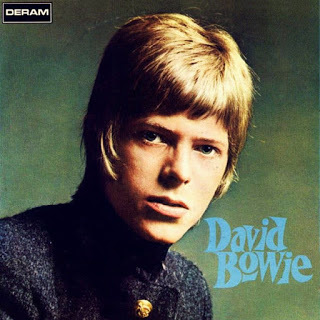 I guess one could go back to St. Mary's Church Choir in Bromley, 1958, for David Jones' first concert performance, but more legitimately (some would argue), Jones's first real concerts gigs were with The Konrads in 1962, The King Bees in January 1964, or The Manish Boys in March 1964. We'll start there. The Manish Boys were Davie Jones (vocals, sax), Johnny Flux (lead), John Watson (guitar, vocals), Bob Solly (organ), Paul Rodriguez (bass, trumpet), Wolfe Byrne (bari sax, harmonica) and Mike White (drums). Jones joined the band in '64 and for the next year, until March 1965, The Manish Boys (changing their name to Davy Jones and the Manish Boys in June) played a myriad of venues (in particular, a six-date tour opening for Gerry and the Pacemakers in December 1964. Also on the bill were The Kinks, Gene Pitney and Marianne Faithful.) and cut their first and only record, "I Pity the Fool" b/w "Take My Tip" in March 1965. In April 1965, Jones joined established band The Lower Third, while continuing to play with The Manish Boys. In August 1965, Davie Jones and The Lower Third supported The Who in Bournemouth.
I guess one could go back to St. Mary's Church Choir in Bromley, 1958, for David Jones' first concert performance, but more legitimately (some would argue), Jones's first real concerts gigs were with The Konrads in 1962, The King Bees in January 1964, or The Manish Boys in March 1964. We'll start there. The Manish Boys were Davie Jones (vocals, sax), Johnny Flux (lead), John Watson (guitar, vocals), Bob Solly (organ), Paul Rodriguez (bass, trumpet), Wolfe Byrne (bari sax, harmonica) and Mike White (drums). Jones joined the band in '64 and for the next year, until March 1965, The Manish Boys (changing their name to Davy Jones and the Manish Boys in June) played a myriad of venues (in particular, a six-date tour opening for Gerry and the Pacemakers in December 1964. Also on the bill were The Kinks, Gene Pitney and Marianne Faithful.) and cut their first and only record, "I Pity the Fool" b/w "Take My Tip" in March 1965. In April 1965, Jones joined established band The Lower Third, while continuing to play with The Manish Boys. In August 1965, Davie Jones and The Lower Third supported The Who in Bournemouth.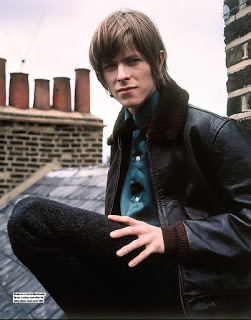 On September 16, 1965, Jones officially and legally changed his name to David Bowie to avoid any conflict with Oliver star (as The Artful Dodger) and Monkee Davy Jones. In February 1966, Bowie held auditions for his new band, tentatively called The Buzz; its members included John Hutchinson on guitar, Derek Fearnley on bass, John Eager on drums and Derrick Boyle on drums. Bowie, with backing from The Buzz would start a sojourn at the Marquee club in June 1966.
On September 16, 1965, Jones officially and legally changed his name to David Bowie to avoid any conflict with Oliver star (as The Artful Dodger) and Monkee Davy Jones. In February 1966, Bowie held auditions for his new band, tentatively called The Buzz; its members included John Hutchinson on guitar, Derek Fearnley on bass, John Eager on drums and Derrick Boyle on drums. Bowie, with backing from The Buzz would start a sojourn at the Marquee club in June 1966. This article does not effectively portray the number of dates played by Bowie exerting what would remain an unstoppable work ethic. Amidst gigs with The Lower Third and The Buzz, Bowie soloed with The Bill Saville Orchestra, performed a number of mime acts with a troupe called Turquoise and played with The Strawbs, where he first met Rick Wakeman (Wakeman would go on to be instrumental on Hunky Dory, of course, playing the piano on "Life on Mars").
Bowie's first album originally released in June 1967 is a pretty cool little record. How’s that for skirting the issue that while many debuts remain an artist's greatest effort (think Rickie Lee Jones, The Killers, The Beastie Boys)? If you like quirky mid-60's British pop, then you really can't go wrong here. "Join the Gang" is a rip on "Swinging London" and a personal fave. "Rubber Band" is a fun nostalgia trip on big bands during the Great War. "Uncle Arthur" is a silly song about the ultimate mama's boy. "When I Live My Dream" is generally considered the best song on the disc; it definitely seems the most mature. Even "Sell Me Your Coat" sounds cheerful though the poor guy is freezing to death. David will always be one of rock's greatest songwriters and lyricists and David Bowie has its fair share of hilarious stories of maids, transvestites, models in adverts, megalomaniacs, childhood fantasists and psychotic gravediggers. Not essential listening for 60's psychedelic enthusiasts but more for Bowie completists. In 1967 a 20-year-old genius was obviously having a blast giving commentary on both Mod London and Twentieth-Century England in general.
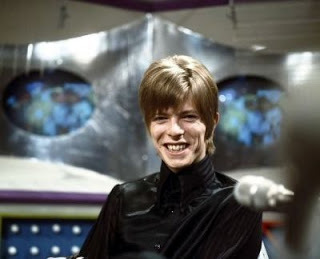 It's quite easy, and seemingly the accepted wisdom, to disregard the album, even pretend it doesn’t exist, yet there is an obvious fondness for narratives and character sketches that will blossom in years to come and define Bowie's ever-shifting persona. Not exactly where one should start with Bowie, his debut album catches him with one foot in the past and one in the future. On the one hand, you have songs in an old-fashioned “easy listening” style with interesting, off-beat lyrics, and on the other you have tracks tied in with the trends of the day - whether the mild psych of "Join the Gang" or the orchestral-trippy "Silly Boy Blue" - with stilted, cliched lyrics.
It's quite easy, and seemingly the accepted wisdom, to disregard the album, even pretend it doesn’t exist, yet there is an obvious fondness for narratives and character sketches that will blossom in years to come and define Bowie's ever-shifting persona. Not exactly where one should start with Bowie, his debut album catches him with one foot in the past and one in the future. On the one hand, you have songs in an old-fashioned “easy listening” style with interesting, off-beat lyrics, and on the other you have tracks tied in with the trends of the day - whether the mild psych of "Join the Gang" or the orchestral-trippy "Silly Boy Blue" - with stilted, cliched lyrics.David Bowie is s a pleasant enough listen; other favorites are probably the cross-dressing rock story "She's Got Medals" or the nostalgia-inducing "There Is a Happy Land" (though the latter's a guilty pleasure, considering how sappy it is), not to mention the gloomy poetry of "Please, Mr Gravedigger." It's just that Bowie's still trying to work out who he is and what he wants to do. His recording track record is similar to that of his extensive touring.
Most of us will begin our journey with Bowie on Space Oddity, where the alien truly finds his voice but also reveals his chameleon-like nature, one that next would explore early heavy metal with The Man Who Sold the World. Years after his debut release, when Bowie became Ziggy and ruled the world, he may have been a bit embarrassed by this record. However, fans of folky, campy rock will enjoy, if only once.
Published on November 14, 2019 07:04



